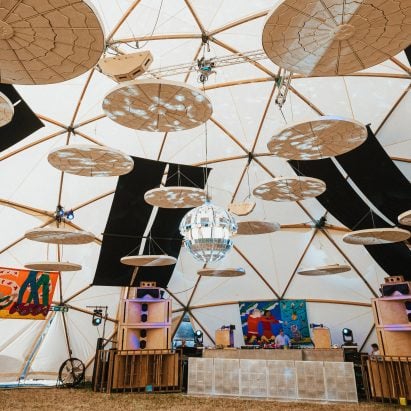Giant acoustic panels grown from hemp and mycelium are dangling from the domed ceiling of a Sunflower Sound System, a new dance music tent at Glastonbury this week.
Set in the festival’s Silver Hayes area, Sunflower Sound System is billed as the first large-scale live music stage to be insulated with mycelium – a promising biomaterial formed from the root structure of fungi.
It was born from a collaboration between British DJ Floating Points and Magical Mushroom Company (MMC).
Sunflower Sound System is said to be the first live music stage to be insulated with mycelium
“It’s never been done in a live event on this scale,” said Paul Gilligan of MMC, which was responsible for designing and manufacturing the panels.
Mycelium is already gaining popularity as a more sustainable alternative to traditional plastic packaging and thermal insulation, one that is entirely compostable and free of fossil fuels.
And acoustics promise to be the industry’s next frontier, according to Gilligan, thanks to mycelium’s natural sound-absorbing qualities.
The material is naturally sound-absorbing
This weekend, MMC is hoping to put these skills to the test under extreme conditions – at one of the world’s largest music festivals.
“We know it’s got the acoustic properties that people want, but they need to see it being used,” Gilligan told Dezeen.
“And there’s nothing better than a dance tent, is there, to prove its performance?”
Towering timber speakers provide the sound
The Sunflower Sound System is centred around a system of six towering timber speaker stacks developed by Floating Points after he became dissatisfied with the variable audio quality offered by festivals.
To reduce echo, reverberation and unwanted reflections inside the tent, Magical Mushroom Company created 25 mycelium acoustic disks, each measuring two metres wide and seven centimetres thick.
The mycelium discs are seven centimetres thick
The panels were carefully engineered in collaboration with the Floating Points sound team to be denser around the edges and more porous in the centre, providing optimal acoustics for revellers on the dance floor while keeping sound from bleeding outside the dome.
Normally, MMC aims for uniformity in its packaging designs and uses waste hemp shivs from agricultural production in a single standard length, which are placed in a mould alongside the mycelium.
The tent has 25 mycelium disks
The mycelium grows to fill the mould and consumes the hemp fibres, fusing them together without any need for plastic binders or coatings.
For the Sunflower Sound System, MMC tweaked the recipe to use substrates of varying lengths to achieve different densities, drawing on research it conducted with engineering graduate student Samuel Fitzgerald Kay.
Each circular disk is composed of 32 identical modules, which Gilligan likens to pizza slices.
Smaller fibres were used to form a denser crust around the outside of the “pizza”, while coarser fibres in the centre create larger pores and allow more sound to pass through.
Each disc has 32 segments
Though Glastonbury’s Sunflower Sound System tent is a “first-of-its-kind”, Gilligan said producing all 25 disks at MMC’s factory in Surrey took just seven days from start to finish.
“We’ve got a very large facility,” he explained. “There are 32 segments in each disc and we could probably make 50,000 of those a week, if we wanted to.”
They take 50 days to degrade in the environment
Half of the substrate used to grow the panels for the Sunflower Sound System actually came from waste MMC packaging that had been sorted out for defects or returned by clients, creating a circular system.
“We’ve got our own pasteuriser in-house,” Gilligan explained. “In fact, it’s the world’s largest liquid inoculation plant. So we can just grind it down, re-sterilise it and then put it back in with the virgin mix.”
Alternatively, the mycelium panels can be broken down into smaller pieces that will degrade in the environment in 50 days, without the need for an industrial composter.
The Sunflower Sound System tent is a “first-of-its-kind”
This makes the mycelium composite especially suited for temporary installations and events like festivals, where long-lived petroleum-based plastics are often used for exceedingly short-lived applications.
Glastonbury’s Silver Hayes area has already been experimenting with mycelium for several years, using it to clad two different editions of its Hayes Pavilion.
But with Sunflower Sound System, the area’s creative producer Ben Price wanted to go one step further and actually integrate the biomaterial into one of its stages to serve a practical, technical purpose.
“We’re excited to keep the momentum going and showcase how sustainable materials like this can truly transform live events,” he said.
The domed stage is one of many at the Glastonbury Festival
In the future, Gilligan envisions setting up an entire mini-factory at Glastonbury’s home on Worthy Farm, where waste from the surrounding agricultural land can be used to grow everything from sound insulation and food packaging to cool boxes for use during the festival.
“The acoustic properties are similar to the thermal properties, so we can produce huge amounts of refrigeration,” he said. “We’ve got tests where we’ve kept fish cold for 14 days.”
“Then, when they’re finished, we can grind the boxes down and reuse them again the following year.”
The post Glastonbury unveils “first-of-its-kind” mycelium-insulated stage appeared first on Dezeen.
